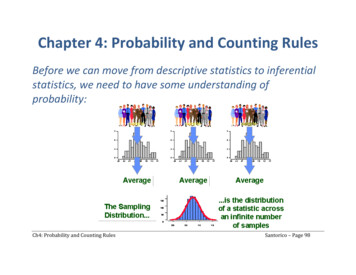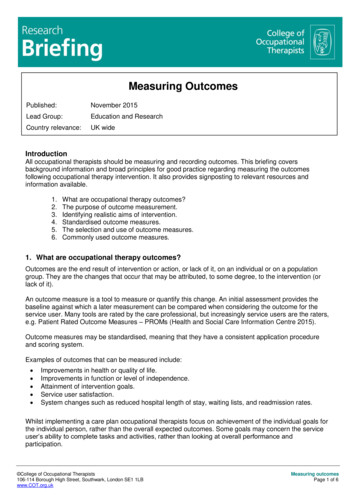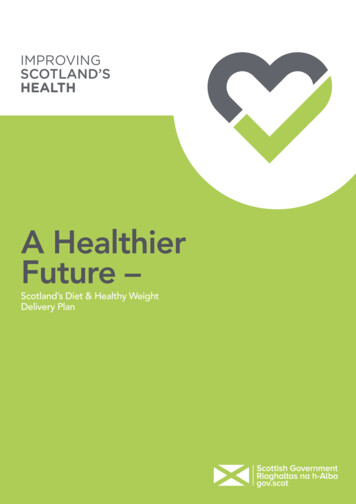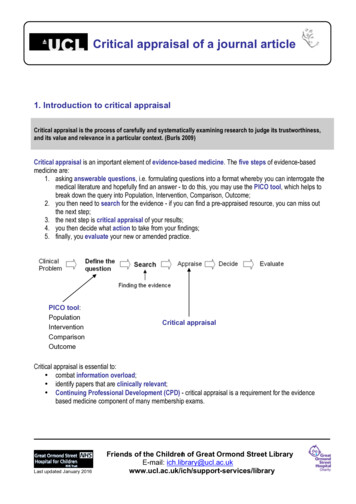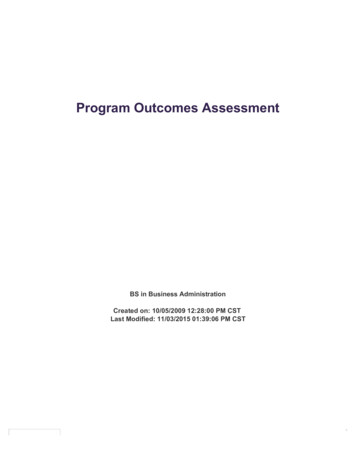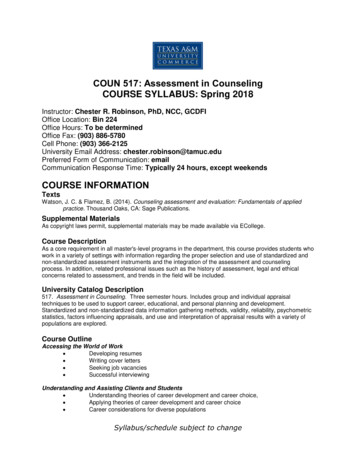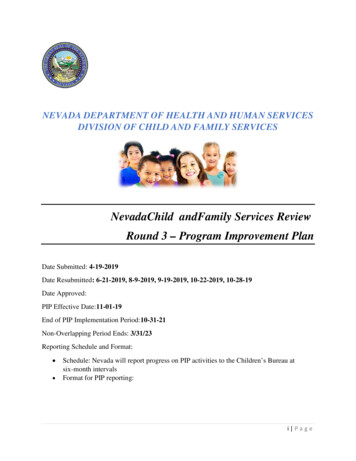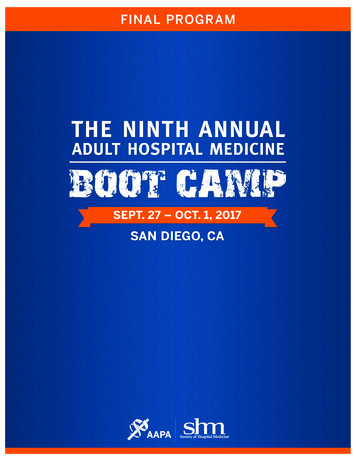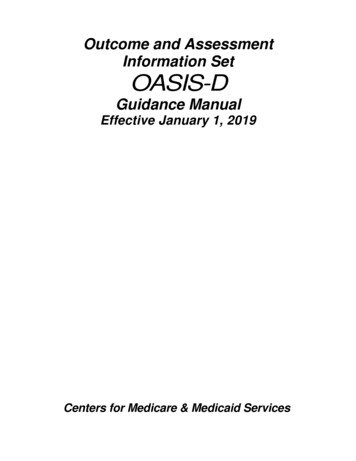
Transcription
Outcome and AssessmentInformation SetOASIS-DGuidance ManualEffective January 1, 2019Centers for Medicare & Medicaid Services
PRA Disclosure StatementAccording to the Paperwork Reduction Act of 1995, no persons are required to respond to a collection ofinformation unless it displays a valid OMB control number. The valid OMB control number for this informationcollection is x. The time required to complete this information collection is estimated to average 0.3 minutes perresponse, including the time to review instructions, search existing data resources, gather the data needed, andcomplete and review the information collection. This estimate does not include time for training. If you havecomments concerning the accuracy of the time estimate(s) or suggestions for improving this form, please write to:CMS, 7500 Security Boulevard, Attn: PRA Reports Clearance Officer, Mail Stop C4-26-05, Baltimore, Maryland21244-1850.*****CMS Disclaimer*****Please do not send applications, claims, payments, medical records or any documentscontaining sensitive information to the PRA Reports Clearance Office. Please note that any correspondence notpertaining to the information collection burden approved under the associated OMB control number listed on thisform will not be reviewed, forwarded, or retained. If you have questions or concerns regarding where to submit yourdocuments, please contact Joan Proctor National Coordinator, Home Health Quality Reporting ProgramCenters for Medicare & Medicaid.
OASIS-D Guidance ManualTable of ContentsPageCHAPTER 1 — INTRODUCTION1-1Preface . 1-1Introduction. 1-1Revision History . 1-1Manual Overview . 1-2Why is OASIS Being Revised Now?. 1-3What’s New with the OASIS-D Assessment Instrument?. 1-3What’s New with the OASIS-D Guidance? . 1-3Collecting OASIS Data. 1-3Eligible Patients. 1-3Time Points . 1-3Who Completes OASIS?. 1-4Comprehensive Assessment and Plan of Care . 1-5Process of Care Data Items . 1-5Conventions for Completing OASIS. 1-6OASIS Data Accuracy. 1-7OASIS Data Encoding and Transmission . 1-8CHAPTER 2 — OASIS-D: ALL ITEMS AND TIME POINTS VERSIONS2-1Introduction. 2-1All Items. 2-2Patient Tracking . 2-33Start of Care (SOC) - Admission to Home Health Care. 2-34Resumption of Care (ROC) after Inpatient Facility Stay . 2-53Follow-up (FU) – Recertification or Other Follow-up . 2-71Transfer to Inpatient Facility (TRN). 2-80Discharge (DC) from Home Health Care, not to an Inpatient Facility. 2-85Death at Home (DAH) . 2-98CHAPTER 3 — OASIS ITEM GUIDANCE3-1Introduction. 3-1Patient Tracking .3-AOASIS-D Guidance ManualEffective 1/1/2019Centers for Medicare & Medicaid Servicesiii
OASIS-D Guidance Manual Table of ContentsClinical Record Items .3-BPatient History and Diagnoses . 3-CLiving Arrangements . 3-DSensory Status.3-EIntegumentary .3-FRespiratory Status . 3-G[Intentionally Left Blank]. 3-HElimination Status . 3-INeuro, Emotional, and Behavioral Status. 3-JADLs / IADLs .3-KMedications. 3-LCare Management . 3-MTherapy Need . 3-NEmergent Care. 3-ODischarge.3-PFunctional Abilities and Goals . 3-GGHealth Conditions. 3-JCHAPTER 4 — [Intentionally Left Blank]4-1CHAPTER 5 — RESOURCES / LINKS5-1AppendicesAppendix A: OASIS and the Comprehensive Assessment.A-1Appendix B: OASIS Data Accuracy .B-1Appendix C: OASIS-D Items, Time Points, and Uses . C-1Appendix D: [Intentionally Left Blank] . D-1Appendix E: Data Reporting Regulations .E-1Appendix F: OASIS and Quality Improvement.F-1Appendix G: Description of Changes from OASIS-C2 to OASIS D . G-1OASIS-D GuidanceEffective 1/1/2019Centers for Medicare & Medicaid Servicesiv
OASIS Guidance ManualCHAPTER 1Chapter 1OASIS GUIDANCE MANUAL INTRODUCTIONPREFACEThis manual provides guidance for home health agencies (HHAs) on how to ensure the collection of high-quality(accurate) OASIS data. It includes both general data collection conventions and item-specific guidance, as well aslinks to resources for agencies.Since OASIS collection was implemented in 1999, national interest in the area of home health care qualitymeasurement and improvement has been ongoing. CMS received hundreds of comments about OASIS from avariety of sources: providers, professional organizations (e.g., American Nurses Association and the AmericanPhysical Therapy Association), home care provider organizations, accrediting organizations, researchers, etc. Inaddition, individuals and groups with expertise in health care quality measurement, such as the Medicare PaymentAdvisory Commission (MedPAC), the National Quality Forum (NQF), and many technical expert panelscommissioned by CMS to guide OASIS evolution have offered suggestions for improving OASIS and expanding thedomains of home health quality measurement to address the six aims (safety, timeliness, effectiveness, efficiency,equity, and patient-centeredness) articulated by the Institute of Medicine in their 2001 report “Crossing the QualityChasm.”Input from the NQF, a nonprofit organization that endorses national consensus standards for measuring and publiclyreporting on performance has been especially valuable in guiding the evolution of OASIS and associatedperformance reports. NQF-endorsed voluntary consensus standards are widely viewed as the gold standard formeasurement of health care quality. NQF has endorsed a number of OASIS-based quality measures for publicreporting. Endorsed measures are periodically reviewed for continuing endorsement, and, as measure developmentcontinues, new or revised measures are submitted to NQF for review.INTRODUCTIONThe Outcome and Assessment Information Set (OASIS) is a group of standard data elements developed, tested, andrefined over the course of two decades through a research and demonstration program funded primarily by theCenters for Medicare & Medicaid Services (CMS), with additional funding from the Robert Wood Johnson Foundationand the New York State Department of Health. OASIS data elements were designed to enable systematiccomparative measurement of home health care patient outcomes at two points in time.OASIS-based quality measures can be used for quality improvement efforts that home health agencies (HHAs) canemploy to assess and improve the quality of care they provide to patients. CMS provides HHAs with numerous qualitymeasure reports including outcome, process, potentially avoidable event, patient-related characteristic, and patienttally reports. Reports are provided for up to two time intervals selected by the HHA requesting the reports. Processquality measures include indicators of how often the HHA follows best practices to improve patient outcomes.Outcome measures include end-result functional and physical health improvement/stabilization, health care utilizationmeasures, and potentially avoidable events. Potentially avoidable events are negative outcomes that clinicalevidence indicates can be influenced (although not necessarily totally avoided) by following best practices inproviding care. In addition to quality measurement, certain OASIS data elements are used to adjust per-episodepayment rates for patient conditions that affect care needs.REVISION HISTORY1.OASIS C Guidance Manual Original Publication: September 20092.Revision 1: December 20093.Revision 2: January 20114.Revision 3: January 2012OASIS-D Guidance ManualEffective 1/1/2019Centers for Medicare & Medicaid ServicesChapter 1-1
OASIS Guidance Manual5.Revision 4: December 20126.OASIS-C1/ICD-9 Guidance Manual: June 2014Chapter 1Note: Past revisions of the guidance manual have included an “errata” document that indicated wherechanges had occurred so that HHAs could replace only those manual pages that had changed. Because thisrevision is substantially more extensive than previous updates, this manual was intended to replace in itsentirety the OASIS-C Guidance Manual and as such, changes to specific sections or pages were nottracked. However, there was a table included at the beginning of Chapter 3 that indicated which OASISitems and which item-by-item guidance sections had been revised.7.OASIS-C1/ICD-9 Guidance Manual: January 2015Changes in this version included a new Chapter 2, in which the “draft” notation was removed from theOASIS forms and the OMB number was added to each time point version. The footer date throughout theentire manual was changed to January 2015.8.OASIS-C1/ICD-10 Guidance Manual: October 2015This version of the manual included changes required to incorporate the newly-implemented ICD-10-CMcodes into both the guidance manual and the corresponding OASIS-C1 data set items. The footer waschanged in all chapters, including those that did not have changes related to the implementation of ICD-10CM.9.OASIS-C2 Guidance Manual: Effective January 1, 2017This version of the manual replaces the previous version in its entirety. This version includes changesrequired for standardization with other post-acute care data sets. Three new standardized items andguidance, and five revised items and guidance are included in this version. Other changes include guidancefor a revised look-back period for five items, and clarifications in response to questions submitted to theOASIS Help Desk.10. OASIS-C2 Guidance Manual: Effective January 1, 2018This version of the manual replaces the previous version in its entirety. This version includes corrections andupdates, including but not limited to errors listed in the September OASIS-C2 Guidance Manual Errata, andnew guidance made available in October 2016 and February 2017 CMS National Provider Training Q&Adocuments.11. OASIS D Guidance Manual: Effective January 1, 2019This version of the manual introduces new and modified items. Some are standardized patient assessmentdata elements (SPADEs), added to meet the requirements of the Improving Medicare Post-Acute CareTransformation Act of 2014 (IMPACT Act). Standardized guidance for the new items is included. Themanual also includes revisions to correct, update or clarify guidance. (See Appendix G for a summary ofchanges from OASIS-C2 to OASIS-D).MANUAL OVERVIEWChapter 1–The Introduction, which provides contextual information and other general information relevantto OASIS data collection.Chapter 2–Includes versions of the OASIS data set for each data collection time point.Chapter 3–Contains item-specific guidance, subdivided into sections.Chapter 4–Illustrative Examples are retired. Page intentionally left blank.OASIS-D Guidance ManualEffective 1/1/2019Centers for Medicare & Medicaid ServicesChapter 1-2
OASIS Guidance ManualChapter 5–Appendices –Chapter 1Includes relevant resources for HHAs, with hyperlinks when available.Include additional contextual information, including sections on OASIS and the comprehensiveassessment, home health care regulations related to OASIS data collection, andrecommendations for ensuring accuracy of OASIS data.WHY IS OASIS BEING REVISED NOW? HHAs began collecting and transmitting OASIS data for adult skilled Medicare and Medicaid patients (withthe exception of maternity patients) in 1999. Since 1999, numerous changes have occurred within the healthcare system, including specific recommendations for changes in the area of home health care qualitymeasurement. Currently the main reason for revising OASIS is to increase standardization across post-acute care (PAC)settings to enable calculation of standardized, cross-setting QMs, pursuant to the provisions of the IMPACTAct. Standardized patient assessment data elements (SPADEs) are questions and response options that areidentical in all four PAC assessment instruments, and to which identical standards and definitions apply.WHAT’S NEW WITH THE OASIS-D ASSESSMENT INSTRUMENT? New items are addedDifferent time point versions of some itemsRemoval of itemsRevision of some itemsUpdated Skip PatternsWHAT’S NEW WITH THE OASIS-D GUIDANCE? Chapter 3, two new sections of standard guidance added:‒‒Section J – Health ConditionsSection GG – Functional Abilities and GoalsChapter 4, Illustrative Examples are retiredRemoval of many items and their corresponding guidanceRevisions to existing Guidance for some OASIS items to update or clarify informationAppendix F - sample reports are not included in this version. Users may refer to the Casper Reporting UserManual, Section 6, OASIS Quality Improvement Reports, located at: https://qtso.cms.gov/hhatrain.htmlCOLLECTING OASIS DATAThis section will provide a basic overview for collecting OASIS data. For more detail on clinical strategies forcollecting OASIS data as part of a comprehensive assessment, refer to Chapter 3 of this manual.ELIGIBLE PATIENTSOASIS data are collected for Medicare and Medicaid patients, 18 years and older, receiving skilled services, with theexception of patients receiving services for pre- or postnatal conditions. Those receiving only personal care,homemaker, or chore services are excluded since these are not considered skilled services.TIME POINTSOASIS data are collected at the following time points:OASIS-D Guidance ManualEffective 1/1/2019Centers for Medicare & Medicaid ServicesChapter 1-3
OASIS Guidance Manual Chapter 1Start of careResumption of care following inpatient facility stayRecertification within the last five days of each 60-day recertification periodOther follow-up during the home health episode of careTransfer to an inpatient facilityDeath at homeDischarge from agencyAll of these assessments, with the exception of transfer to inpatient facility and death at home, require the clinician tohave an in-person encounter with the patient during a home visit. The transfer to an inpatient facility requirescollection of limited OASIS data (most of which may be obtained through a telephone call). Not all OASIS items arecompleted at every assessment time point. Some items are completed only at start of care, some only at discharge.The table of “Items to be Used at Specific Time Points” included at the beginning of the OASIS data set allows thehome health agency (or its selected medical record vendor) to integrate the necessary OASIS items at each timepoint into clinical documentation forms or an electronic health record.At the start of care time point, the comprehensive assessment should be completed within five days after the start ofcare date.At the resumption of care, the comprehensive assessment must be completed within 48 hours of return home afterinpatient facility discharge, or within 48 hours of knowledge of a qualifying stay in an inpatient facility. A physicianordered resumption of care (ROC) must be conducted on or within 2 calendar days of the physician-ordered ROCdate.For the transfer to inpatient facility, discharge from home care, death at home, and other follow-up, the assessmentsmust be completed on, or within 48 hours of becoming aware of the significant change in condition, transfer,discharge, or death date.WHO COMPLETES OASIS?As identified in (M0080) Discipline of Person Completing Assessment, the comprehensive assessment and OASISdata collection are the responsibility of a registered nurse (RN) or any of the therapies, including physical therapist(PT), speech language pathologist/speech therapist (SLP/ST), or occupational therapist (OT). A licensed practicalnurse or licensed vocational nurse (LPN/LVN), physical therapy assistant (PTA), occupational therapy assistant(OTA), medical social worker (MSW), or Aide may not be responsible for completing OASIS assessments.In cases involving nursing, the RN is responsible for completing the comprehensive assessment document at theSOC, and may elicit input from the patient, caregivers, and other health care personnel, including the physician, thepharmacist and/or other agency staff to assist in completion of any or all OASIS items. Any discipline qualified toperform assessments – RN, PT, SLP, OT – may complete subsequent assessments. For a therapy-only case, thetherapist usually conducts the comprehensive assessment. It is acceptable for a PT or SLP to conduct and completethe comprehensive assessment at SOC for a Medicare patient.An OT may conduct and complete the assessment when the need for occupational therapy establishes programeligibility. Note: Occupational therapy alone does not establish eligibility for the Medicare home health benefit at thestart of care; however, occupational therapy may establish eligibility under other programs, such as Medicaid. TheMedicare home health patient who is receiving services from multiple disciplines (for example, skilled nursing,physical therapy, and occupational therapy) during the episode of care, can retain eligibility if, over time, occupationaltherapy is the only remaining skilled discipline providing care. At that time, an OT can conduct OASIS assessments.Multidisciplinary cases may have multiple points of discipline-specific discharge, though there is only one HHAdischarge, which must include completion of the OASIS discharge comprehensive assessment. Other non-OASISrequired documentation for recertification and discharge are specified in the Condition of Participation:OASIS-D Guidance ManualEffective 1/1/2019Centers for Medicare & Medicaid ServicesChapter 1-4
OASIS Guidance ManualChapter 11Comprehensive Assessment of Patients. OASIS items were designed to be discipline-neutral and have been testedand validated with clinicians from various disciplines.COMPREHENSIVE ASSESSMENT AND PLAN OF CAREOASIS data are collected as part of the comprehensive assessment required by the Medicare Conditions ofParticipation (see Appendix A of this manual). OASIS is not intended to represent a comprehensive assessment inand of itself. HHAs are expected to incorporate OASIS items into their comprehensive assessment documentationand follow their own assessment policies and procedures. Agencies are free to rearrange OASIS item sequence in away that permits logical ordering within their own forms, as long as the actual item content, skip patterns, and OASISnumber remain the same. Like other comprehensive assessment documentation, OASIS data are collected using avariety of strategies, including observation, interview, review of pertinent documentation when allowed (for example,hospital discharge summaries), discussions with other healthcare providers where relevant (for example, phone callsto the physician to verify diagnoses), and measurement (for example, intensity of pain). Although one clinician musttake responsibility for the comprehensive assessment, collaboration with the patient, caregivers, and other healthcare personnel, including the physician, pharmacist, and/or other agency staff is appropriate. For items requiringpatient assessment, the collaborating healthcare providers must have had direct contact with the patient. OASIS datashould be collected at each time point based on a unique patient assessment, not simply carried over from a previousassessment. Comprehensive assessment data form the basis of the physician-ordered Plan of Care. Thus, thereshould be congruence between documentation of findings from the comprehensive assessment and the Plan of Care.Agencies may have the comprehensive assessment completed by one clinician. If collaboration with other health carepersonnel and/or agency staff is utilized, the agency is responsible for establishing policies and practices related tocollaborative efforts, including how assessment information from multiple clinicians will be documented within theclinical record, ensuring compliance with applicable requirements, and accepted standards of practice.PROCESS OF CARE DATA ITEMSProcess of care data items (process items) document whether certain evidence-based practices were implemented.Process items collected at SOC/ROC document assessment such as whether the patient was assessed to be at riskfor certain conditions like falls. These items refer to assessments that were completed within the five-day SOC periodor the two-day ROC period.Process items collected at transfer and discharge time points include documentation of interventions implemented aspart of patient care at the time of or since the most recent start of care or resumption of care. Specific instructionsabout review periods are included in item guidance for the relevant OASIS items.Process items collected at transfer and discharge may require a clinician to review documentation of care providedduring the home health episode in order to accurately complete the items. Note that this review must consider careprovided by all disciplines, and is not limited to care provided by the discipline of the clinician completing the OASISassessment. The review can be accomplished in several different ways. The care provider may find it necessary toreview clinical records, including the Plan of Care, updated orders, and visit notes. Alternatively, the agency mayelect to create a flowsheet with the appropriate parameters that are checked off on each visit. Review of theflowsheet may provide the needed information, such that a review of the clinical record would be unnecessary.Another strategy for agencies using electronic health records is to create a report template that could pull the neededinformation from data fields incorporated into visit notes. Regardless of the technique that an agency chooses, theprocess data items completed at transfer and discharge will require knowledge of patient symptoms, initial andsubsequent physician’s orders, and clinical interventions performed to address patient symptoms that were present atthe time of or since the most recent SOC/ROC R?gp &SID 1c743ade23ae8533ee0732689c166e31&r PART&n 42y5.0.1.1.3#se42.5.484 155OASIS-D Guidance ManualEffective 1/1/2019Centers for Medicare & Medicaid ServicesChapter 1-5
OASIS Guidance ManualChapter 1CONVENTIONS FOR COMPLETING OASISListed below are conventions, or general rules, that should be observed when completing OASIS. Item-specificguidance is provided in Chapter 3. The OASIS Guidance is updated periodically to provide additional clarificationbased on “Frequently Asked Questions” sent to CMS. (A link to Frequently Asked Questions is provided in Chapter5). It is not possible to address all of the situations that arise, due to the rare and unique nature of some of thequestions, and exceptions that may be encountered in clinical practice.Each patient scenario, clinical status, social and environmental situation is unique, requiring professional/clinicaljudgment and care coordination. In the event you cannot resolve your understanding of the OASIS questions, CMSwill continue to provide avenues to accept and respond to questions.GENERAL OASIS ITEM CONVENTIONS1.Understand the time period under consideration for each item. Report what is true on the day of assessmentunless a different time period has been indicated in the item or related guidance. Day of assessment isdefined as the 24 hours immediately preceding the home visit and the time spent by the clinician in thehome.2.For OASIS purposes, a quality episode must have a beginning (that is, an SOC or ROC assessment) and aconclusion (that is, a Transfer, Discharge, Death at Home assessment) to be considered a complete qualityepisode.3.If the patient’s ability or status varies on the day of the assessment, report the patient’s “usual status” orwhat is true greater than 50% of the assessment time frame, unless the item specifies differently.4.Minimize the use of NA and Unknown responses.5.Some items allow a dash response. A dash (–) value indicates that no information is available. CMS expectsdash use to be a rare occurrence.6.Responses to items documenting a patient’s current status should be based on observation of the patient’scondition and ability at the time of the assessment without referring back to prior assessments ordocumentation of status from a prior care setting. Several process items require review of documentation ofcare that occurred at the time of or at any time since the most recent SOC or ROC OASIS assessment.These instructions are included in item guidance for the relevant OASIS items.7.Combine observation, interview, collaboration with other agency staff and other relevant strategies tocomplete
data elements (SPADEs), added to meet the requirements of the Improving Medicare Post-Acute Care Transformation Act of 2014 (IMPACT Act). Standardized guidance for the new items is included. The manual also includes revisions to correct, update or clarify guidance. (See Appendix G for a summary of changes from OASIS-C2 to OASIS-D). MANUAL OVERVIEW
